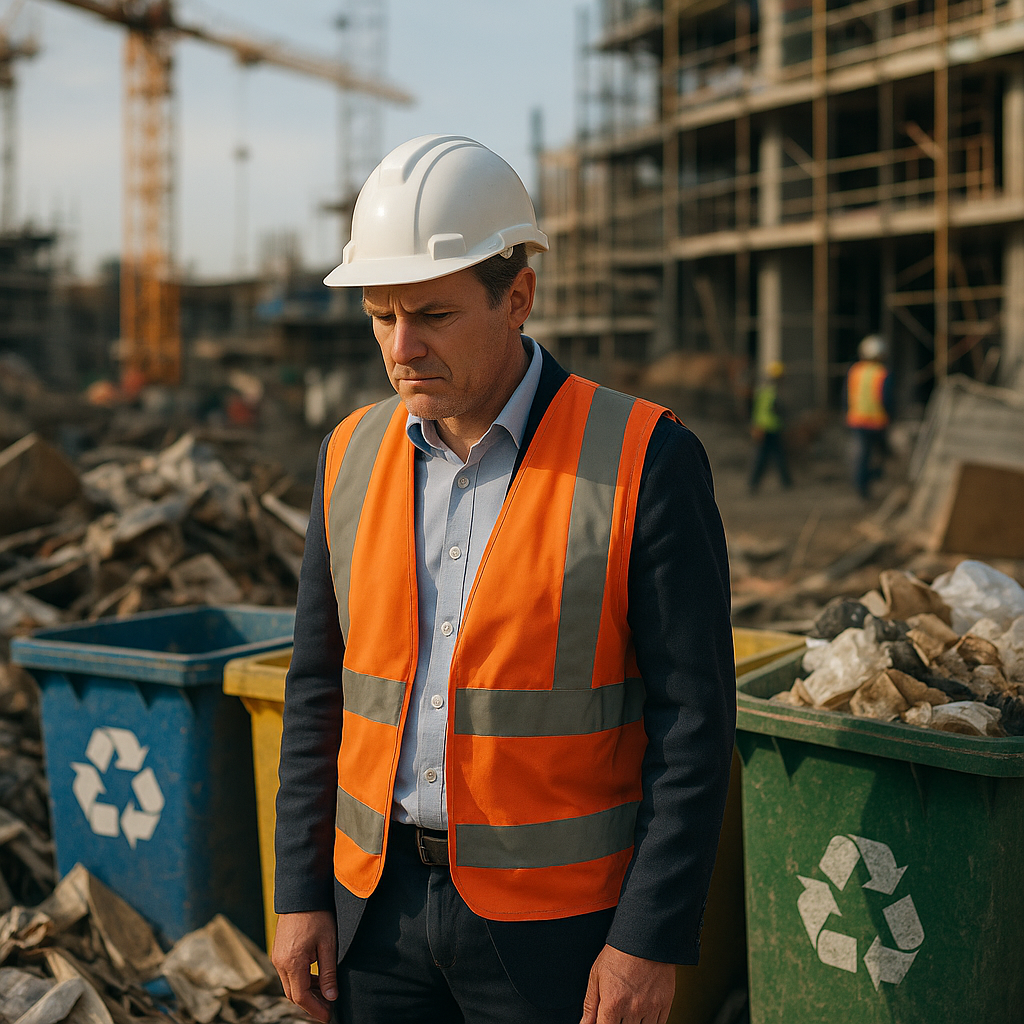5901 Botham Jean Blvd, Dallas, TX 75215
Discover the Environmental Benefits of On-Site Recycling
August 14, 2025Did you know that the construction industry generates over one-third of all waste in most developed countries? This statistic underscores why on-site recycling has become an important environmental strategy. On-site recycling offers significant environmental benefits by keeping materials in use at their original location.
On-site recycling reduces the need for raw material extraction substantially. When construction materials like concrete, wood, and metals are processed and reused on-site, we conserve virgin resources. The numbers are compelling: recycling one ton of steel saves 2,500 pounds of iron ore, 1,400 pounds of coal, and 120 pounds of limestone.
Beyond conserving resources, on-site recycling significantly cuts greenhouse gas emissions by eliminating or reducing the need for transportation. When materials aren’t transported to distant processing facilities, fuel consumption drops dramatically. This approach also diverts substantial waste from landfills, extending their useful life and reducing the harmful methane emissions that occur when organic materials decompose there.
How Does On-Site Recycling Improve Project Efficiency?

On-site recycling transforms construction waste management into a strategic advantage for project efficiency. Processing materials directly at the job site streamlines workflows, allowing construction teams to spend less time on waste handling and transportation. This shift lets workers focus more on tasks that add value.
The productivity gains are both substantial and measurable. Projects with comprehensive on-site recycling report productivity improvements of 5-15%. These gains come from reduced material handling time, decreased site congestion, and more organized workspaces, allowing trades to work without unnecessary obstacles.
Site organization improves dramatically with on-site recycling systems. Designated sorting areas for different materials create clear pathways, eliminating the clutter typical of mixed waste accumulation. This organization provides workers with cleaner, more efficient spaces.
Workplace Safety Enhancements
Beyond productivity, on-site recycling significantly improves workplace safety. Properly sorted and managed materials reduce common hazards on construction sites. Fewer protruding objects and obstructed pathways lead to fewer accidents.
This safety impact is especially important in high-traffic areas. Sites with established recycling systems report fewer work stoppages due to accidents, keeping projects on schedule and reducing the costs associated with workplace injuries and their administrative burdens.
Streamlined Material Management
On-site recycling allows for immediate material reuse, avoiding delays from off-site processing. For example, concrete crushing equipment can transform demolition waste into usable aggregate for new foundations or roadbeds quickly. This rapid turnaround keeps projects progressing without waiting for material deliveries.
The logistics benefits go beyond timing. Recycling on-site reduces truck traffic around the project, decreasing congestion and emissions while minimizing disruption to surrounding communities. This keeps the site more accessible for essential deliveries.
Key Efficiency Gains from On-Site Recycling
- Reduced material handling time and labor costs
- Decreased waste transportation and disposal expenses
- Minimized site congestion and improved workflow
- Lower accident rates and fewer work stoppages
- Immediate availability of recycled materials
- Streamlined compliance with waste management regulations
Case Study: The High Tower Development
A recent commercial development in Seattle illustrates the efficiency benefits of on-site recycling. The High Tower project implemented an on-site recycling system during both demolition and construction phases. Concrete from the previous structure was crushed on-site and reused as structural fill and road base, while wood waste was processed into mulch for landscaping.
The results were impressive. The project reported a 12% overall productivity improvement compared to similar past projects. Work stoppages due to waste-related accidents decreased by 78%, and consistent workflow was maintained throughout construction. Notably, the immediate availability of recycled aggregate saved an estimated three weeks in the project schedule by avoiding delays in virgin material deliveries during regional supply shortages.
This case highlights how strategic on-site recycling fosters a virtuous cycle of efficiency. Better organization improves safety, supporting continuous productivity and ultimately delivering projects on time and often under budget. For construction managers seeking to enhance performance, on-site recycling is one of the most effective operational improvements available.
What are the Economic Advantages of On-Site Recycling?

On-site recycling offers immediate financial benefits by significantly reducing disposal costs. Construction and demolition projects using on-site recycling programs can typically cut landfill fees by up to 50%, due to the reduction in waste volumes needing off-site disposal. For larger commercial projects, these savings can quickly amount to five-figure sums.
Reducing transportation costs is another major economic advantage. Processing materials on-site reduces the need for waste hauling. Fewer truck trips mean lower fuel consumption, less vehicle maintenance, and reduced labor hours dedicated to waste transport. Some projects report transportation savings of up to 30% with comprehensive on-site recycling.
Beyond cost savings, on-site recycling creates valuable revenue streams. Metals, clean wood, and certain plastics hold considerable market value when properly sorted and processed. Steel, copper, and aluminum are especially lucrative, with a medium-sized construction project potentially generating thousands of dollars through strategic recycling of these metals.
Using recycled materials in new construction phases adds further economic benefits. Recycled concrete aggregate often costs 20-30% less than virgin aggregate, while maintaining similar performance characteristics. This cost differential can lead to substantial savings for projects requiring large amounts of aggregate material.
Efficiency improvements from structured recycling programs extend beyond material costs. Construction sites implementing on-site recycling report enhanced operational productivity through better organization and streamlined material handling. Workers spend less time managing waste and more time on value-adding construction activities, improving overall project timelines by 5-15% in many cases.
For typical commercial construction projects, the combined financial impact of comprehensive recycling is substantial. A project generating 500 tons of waste might incur $25,000-$35,000 in traditional disposal costs. With on-site recycling, these expenses typically drop to $10,000-$15,000 while simultaneously generating $3,000-$8,000 in material sales. This creates a total financial benefit between $18,000 and $28,000.
The economic case for on-site recycling strengthens further when considering regulatory compliance. Many municipalities now require minimum recycling rates for construction and demolition projects. Proactive implementation of on-site recycling programs helps avoid potential fines and project delays due to non-compliance.
The Green Tower residential project in New York City exemplifies these economic principles. The development team implemented a comprehensive on-site sorting system with an ambitious 85% waste diversion goal, ultimately achieving 87% diversion and saving $150,000 in disposal costs compared to traditional methods. This success boosted the developer’s reputation and helped secure future contracts with sustainability-focused clients.
The long-term economic benefits extend beyond individual projects. Companies with established recycling programs gain competitive advantages in bidding processes, as clients increasingly prioritize environmental responsibility. This market differentiation translates into more contracts and higher profitability. For construction firms, recycling is both an environmental and a sound financial strategy with measurable returns.
What are the Challenges of Implementing On-Site Recycling?

On-site recycling offers substantial benefits for construction sites and businesses, but several practical challenges can hinder its implementation. Understanding these obstacles is crucial for developing effective strategies to overcome them.
Space Constraints
One of the most immediate challenges of on-site recycling is the need for additional space. Multiple bins for different materials (wood, metal, cardboard, plastic) require significant square footage. This is particularly problematic at urban construction sites where space is already scarce.
Construction companies can address space limitations by implementing tiered or stacked bin systems to maximize vertical space. Another approach is scheduling more frequent pickups of smaller containers rather than using fewer large ones. Some companies designate specific areas that rotate throughout the project timeline as recycling zones.
Employee Training Requirements
Effective on-site recycling requires comprehensive training for all workers. Staff must know which materials go into each bin, how to prevent contamination, and why proper sorting matters. This training takes time away from other tasks and requires ongoing reinforcement.
To streamline the training process, companies can develop visual guides with images of acceptable materials for each bin. Regular toolbox talks specifically focused on recycling procedures can reinforce proper practices. Some construction firms assign recycling champions on each site to monitor compliance and provide on-the-spot guidance.
Contamination Risks
Perhaps the most significant challenge is contamination. When non-recyclable items or incorrect recyclables end up in collection bins, entire loads can be rejected by recycling facilities, undermining the program’s effectiveness and sending properly sorted materials to landfills.
Reducing contamination starts with clear labeling on bins, including both text and images showing acceptable materials. Regular quality checks of bin contents can identify problem areas before contamination becomes widespread. Some companies implement a two-stage sorting process, with initial on-site sorting followed by verification before materials leave the site.
Increased Site Traffic
On-site recycling often increases vehicle traffic as different recycling streams require separate pickups. More trucks entering and exiting the site can create congestion, safety hazards, and scheduling complications, especially on constrained urban sites with limited access points.
Scheduling pickups during off-peak hours can minimize disruption to regular construction activities. Consolidating pickups where possible or working with recycling vendors who can handle multiple material types reduces traffic. Some sites designate specific traffic lanes just for waste management vehicles to avoid conflicts with material deliveries.
Initial Setup Costs
Implementing on-site recycling requires upfront investment in bins, signage, training materials, and potentially additional staffing. These costs can be a barrier, especially for smaller contractors or projects with tight margins.
Companies can offset these costs by tracking reduced landfill tipping fees from diverting materials to recycling. Some regions offer tax incentives or grants for construction waste recycling programs. Sharing resources across multiple project sites can also help distribute initial investment costs.
While these challenges are significant, they are not insurmountable. With proper planning, clear communication, and commitment from leadership, construction companies can implement successful on-site recycling programs that deliver environmental and economic benefits despite these obstacles.
Conclusion: Maximizing the Benefits of On-Site Recycling

On-site recycling offers significant benefits for construction projects seeking sustainable solutions. The environmental advantages include substantial reductions in landfill waste, decreased carbon emissions from transport, and conservation of natural resources. Operationally, companies benefit from streamlined workflows, reduced material handling, and improved site organization. The economic advantages are equally compelling, with lower disposal costs, reduced material purchasing expenses, and potential revenue from recyclable materials.
Construction companies can maximize these benefits by implementing thorough waste audits, using specialized sorting equipment, training staff in proper material handling, and partnering with recycling specialists. For professional guidance on implementing effective on-site recycling programs that meet your sustainability goals while improving your bottom line, contact Okon Recycling at 214-717-4083.
